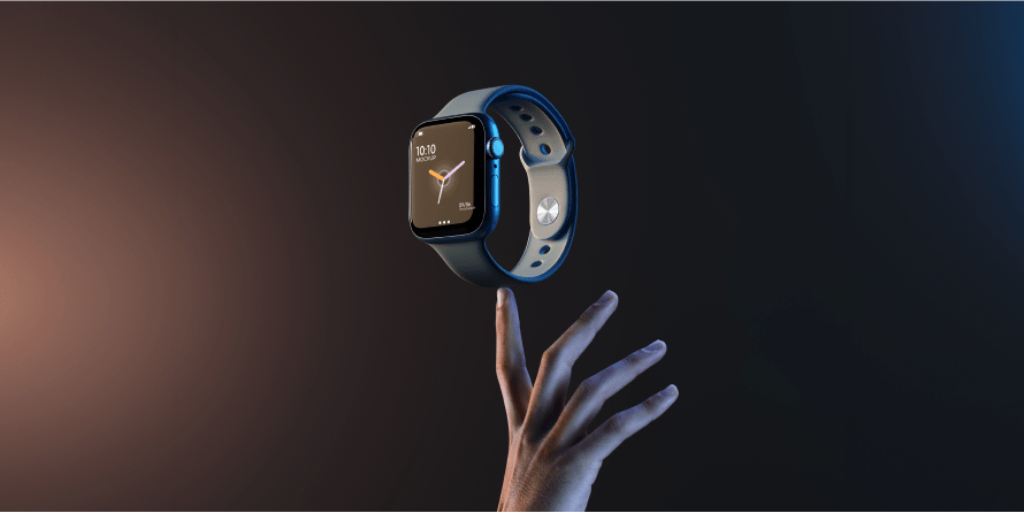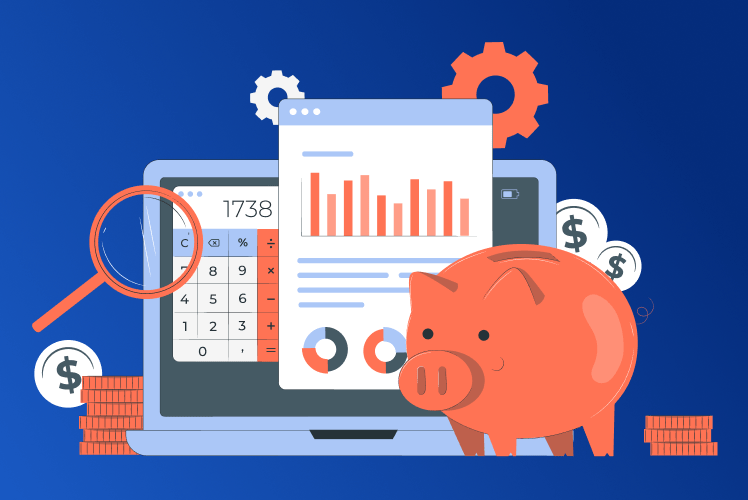Table of Contents
Some time ago, the first iPhone was considered a tech miracle, and look where we are now: checking our wristbands for email notifications. And as the technology progresses, new forms of wearables emerge, from advanced smartwatches to smart jewelry.
In 2021, the global market size of wearable technology was estimated to be US$ 41.1 billion and we can expect it to keep growing. We can also expect new and exciting forms of wearables to appear that will probably be equipped with functions that we can’t even dream of today. But for now, let’s focus on what the wearable technology market currently has to offer in terms of device variety and benefits for both users and particular industries.

A brief overview of wearable technology
Wearable technology is exactly what the name implies: it encompasses various devices that can be worn on any part of the body or on clothing. These devices are microprocessor-based and are capable of sending and receiving data about the user’s body condition and activity. Some of the most common examples of wearables are Apple Watch, Fitbit smartwatch, Xiaomi posture monitors, and Google Glasses.
What makes these devices smart is the wide range of features that they offer. These features may include GPS, physical activity tracking, blood level tracking, push notifications, or an option to receive phone calls. And considering how users are becoming more dependent on technology in terms of everyday use, it makes perfect sense that the market share of wearables is growing in an exponential manner. Here are some interesting numbers to look at:
- The global smartwatch market is expected to grow 19% in 2022 compared to 2021. (Strategy Analytics).
- Wearable headphone devices will exceed $44.16 billion globally in 2022 (Statista).
- The top five wearable device companies by shipments, market share, and annual growth are Apple (34.9% share during the quarter) Xiaomi (8.6%), Samsung (7.9 %), Huawei (6.7%), and Imagine Market (5.4%) (IDC).
Now, what do these numbers have to do with, say, software development? Considering the popularity of wearables, the area is a goldmine for software providers to create mobile apps that can be synced with corresponding devices. As well, wearables are of particular interest to several industries with healthcare being the most demanding one.
The role of wearable technology in healthcare
The COVID-19 pandemic has played a big role in the use of wearable technology. At the beginning of the pandemic, wearables were used mostly to track warning symptoms since many people did not have an opportunity to physically visit a doctor. In this way, wearable devices with health monitoring options became a great alternative to physical visits to medical facilities. However, as the pandemic progressed, the list of applications of wearable technology has expanded significantly. In addition, people started paying more attention to their well-being and health which also impacted the use of wearables.
The use cases of wearable technology in the light of the COVID-19 pandemic include:
- Symptoms tracking;
- Quarantine management;
- Social distance management;
- Stress management.
If we talk about the general use of wearables in healthcare, the range of applications is really vast. The healthcare industry views wearable technology as an efficient method of remote patient monitoring that provides a continuous real-time flow of health data between the patient and the physician. Hence, wearables may be of great assistance in the following areas:
- Health monitoring: wearable devices monitor vital activities (i.e. blood pressure) to help patients be more aware of their health. As well, these devices can inform medical professionals about the users’ health state to further adjust their treatment plan or take appropriate measures.
- Patient rehabilitation: wearable devices can provide help with remote physical therapy by educating users how to perform it properly and they can monitor the effectiveness of rehabilitation at home or in the hospital.
- Diagnosis of diseases: wearable diagnostic devices can detect intermittent symptoms (e.g., palpitations) and notify the user (or the doctor) about them in order for the user to immediately seek medical advice.
It’s worth noting that the list of applications for wearable technology is not limited to healthcare only. Wearables can be used in a number of other industries (i.e. manufacturing, retail, or finances), and due to the fact that they deploy microprocessors, basically, anything can be turned into a wearable if you are bold enough. With this said, let’s look at some examples of wearables that we already see and can experience today.
Smartwatches
Smartwatches are probably the most common type of wearable technology and according to GlobalData, these devices account for nearly 60% of the entire wearables market. Smartwatches can be used as wearable fitness trackers, means of entertainment, and personal assistants and they offer a vast array of functions, like health tracking, GPS, pedometers, social media notifications, and many more.
As for the more sophisticated functions, some models are equipped with an electrocardiogram (which turns these watches into wearable ECG monitors), blood oxygen saturation tracking, or heart rate monitoring options. And according to some tech experts, smartwatches are one of the most advanced technologies since they not only provide us with necessary information but also serve as a point of interaction with other people and our surroundings.
Smart headphones
Modern smart wireless headphones can do much more than just play music. Companies like Oticon, ReSound, and Widex are leading the market with their AI-powered hearing aids. Such advanced headphones can boast the following functionality:
- Enhanced and improved sound quality;
- Voice commands through Siri or Google Assistant;
- Fitness or biometric tracking;
- Control or reduction of the ambient noise;
- Language translation in real-time.
Just to reinforce what we’ve said above, smart headphones offer a reasonable alternative for those who are not yet ready for the cost of traditional hearing aids. The cost of smart headphones is considerably less than the one of average hearing aid, and the wireless design is simply a joy to behold.
Wearable Bio Sensors
Wearable biosensors are portable devices that can be worn on a human body or clothes. Examples include smart bandages, belts, contact lenses, and patches. Since these devices are equipped with sensors, they can continuously process biometric data about a user, such as blood pressure or skin temperature, and report any health issues based on the collected data.
An important thing about WBSs is that they are a great alternative to existing monitoring devices. Prolonged monitoring of vital signs may be uncomfortable for patients because monitoring devices in use are relatively large and require consistent recharging. As well, modern biosensor devices are often resource-inefficient because they simply get discarded when no longer adequate. On the contrary, innovative WBSs are small and almost invisible, thus providing increased comfort for the wearer.
Implantable devices
In relation to the wearable biosensors described above, let’s also talk about the implants that are currently generating endless interest among scientists and promise to be one of the greatest advances in wearable medical technology. An implantable medical device is an embedded technology that is placed in a body or under the skin to monitor one’s diseases or health state. Such implantable devices may come in many forms, like chips, skin implantable sensors, pacemakers, defibrillators, or tattoos.
The value of implantable technology lies in the fact that it not only can monitor one’s condition but also determine the parameters of various diseases and transmit the collected data to a remote center. As well, such devices can automatically perform a certain function based on the sensor’s readings. For example, if one’s blood glucose levels go high, the necessary drug to lower them can be injected automatically. Now, how amazing is that?
Smart jewelry
Last but not least is smart jewelry. In addition to being able to change colors or patterns, these jewelry pieces can also act like smartwatches in terms of functionality. As an example, Rebecca Minkoff bracelets can inform users about incoming emails, calls, and text messages – just like your favorite wristband. And same as fitness trackers, some accessories can track one’s health and stress levels: check out a leaf-shaped Bellabeat LEAF bracelet.
Many well-known jewelry companies, such as Misfit, Bellabeat, InvisaWear and Totwoo, have partnered with mobile accessory companies to create smart jewelry, giving users the ability to monitor and improve their health. This brings us back to the topic of wearables being interconnected with software development and posing a field of opportunities for software providers.
Summing up
Ask a few people what wearable technology will look like in 10 years, and you’ll probably get a different answer from every person. A decade ago, almost no one could have predicted that more than a million people would buy watches that can read your text messages, check the weather and measure your heart rate. But here we are, living the sci-fi fantasy.
So the next question is, how far are technology developers ready to go, and what will be the next trend in the field of wearable technology? We will most probably see the answer to this question in a few years. And in the meantime, there is an array of wearable devices to choose from and enjoy so we highly recommend doing so.



Comments